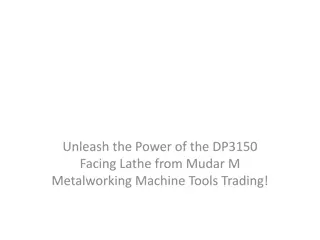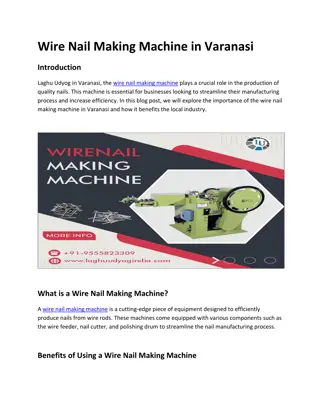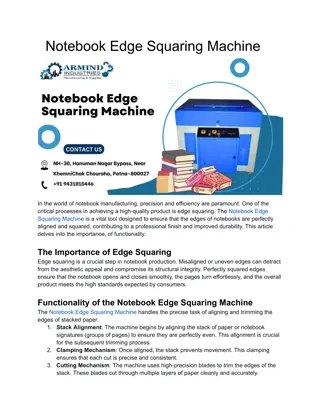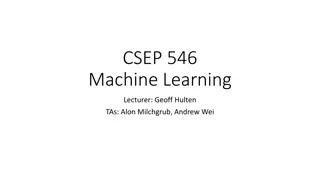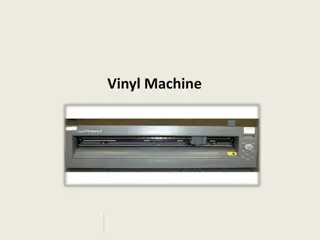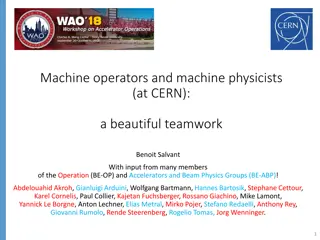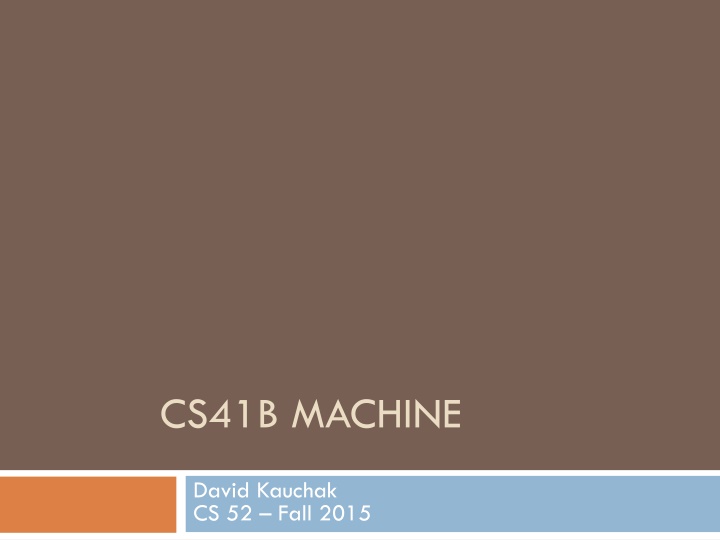
CS41B Machine Operations and Execution
Explore the CS41B machine with CPU instruction details, code types, and execution processes. Learn about operations, arguments, and functions in this introduction to computer science course. Get ready for the admin midterm, and review examples from the lecture for a comprehensive understanding of machine operations.
Download Presentation

Please find below an Image/Link to download the presentation.
The content on the website is provided AS IS for your information and personal use only. It may not be sold, licensed, or shared on other websites without obtaining consent from the author. If you encounter any issues during the download, it is possible that the publisher has removed the file from their server.
You are allowed to download the files provided on this website for personal or commercial use, subject to the condition that they are used lawfully. All files are the property of their respective owners.
The content on the website is provided AS IS for your information and personal use only. It may not be sold, licensed, or shared on other websites without obtaining consent from the author.
E N D
Presentation Transcript
CS41B MACHINE David Kauchak CS 52 Fall 2015
Admin Midterm Thursday Review question sessions tonight and Wednesday Assignment 3? Assignment 4 out soon Due Monday 10/12
Examples from this lecture http://www.cs.pomona.edu/~dkauchak/classes/cs52/examples/cs41b/
CS41B machine CPU instruction counter (location in memory of the next instruction in memory) processor ic r0 holds the value 0 (read only) r1 - - general purpose read/write r2 registers r3
CS41B code Four main types of operations math branch/conditionals memory control the machine (e.g. stop it) 1. 2. 3. 4.
operation name (always three characters)
operation arguments R = register (e.g. r0) S = signed number (byte)
operation function dest = first register src0 = second register src1 = third register arg = number/argument
adc r1 r0 8 neg r2 r1 sub r2 r1 r2 What number is in r2?
adc r1 r0 8 neg r2 r1 sub r2 r1 r2 r1 = 8 r2 = -8, r1 = 8 r2 = 16
sto = save data in register TO memory loa = put data FROM memory into a register Special cases: - saving TO (sto) address 0 prints - reading from (loa) address 0 gets input from user
Basic structure of CS41B program ; great comments at the top! ; instruction1 instruction2 ... hlt end ; comment ; comment whitespace before operations/instructions
Running the CS41B machine Look at subtract.a41 - load two numbers from the user - subtract - print the result
CS41B simulater Different windows Memory (left) Instruction execution (right) Registers I/O and running program
Modify ic, the instruction counter which changes the flow of the program!
beq r3 r0 done What does this do?
beq r3 r0 done If r3 = 0, branch to the label done if not (else) ic is incremented as normal to the next instruction
ble r2 r3 done What does this do?
ble r2 r3 done If r2 <= r3, branch to the label done
- - - Conditionals Loops Change the order that instructions are executed
Basic structure of CS41B program ; great comments at the top! ; instruction1 instruction2 ... label1 instruction instruction label2 ... hlt end ; comment ; comment ; comment ; comment - whitespace before operations/instructions - labels go here
More CS41B examples Look at max_simple.a41 - Get two values from the user - Compare them - Use a branch to distinguish between the two cases - Goal is to get largest value in r3 - print largest value
What does this code do? bge r3 r0 elif sbc r2 r0 1 brs endif elif else endif beq r3 r0 else adc r2 r0 1 brs endif add r2 r0 r0 sto r0 r2 hlt end
What does this code do? bge r3 r0 elif sbc r2 r0 1 brs endif if( r3 < 0 ){ r2 = -1 elif else endif beq r3 r0 else adc r2 r0 1 brs endif }else if( r3 != 0 ){ r2 = 1 }else{ r2 = 0 } add r2 r0 r0 sto r0 r2 hlt end
What does this code do? bge r3 r0 elif sbc r2 r0 1 brs endif ; if r3 >= 0 go to elif ; r3 < 0: r2 = -1 ; jump to end of if/elif/else elif else endif beq r3 r0 else adc r2 r0 1 brs endif ; if r3 = 0 go to else ; r3 > 0: r2 = 1 ; jump to end of if/elif/else add r2 r0 r0 ; r3 = 0: r2 = 0 sto r0 r2 hlt end ; print out r2
Memory layout 0 Code Where dynamically allocated program data is stored Heap Where program/function execution information is stored, parameters, and local variables Stack
Stacks Two operations push: add a value in the register to the top of the stack pop: remove a value from the top of the stack and put it in the register
Stack frame Key unit for keeping track of a function call - return address (where to go when we re done executing) - parameters - local variables
CS41B function call conventions r1 is reserved for the stack pointer r2 contains the return address r3 contains the first parameter additional parameters go on the stack (more on this) the result should go in r3
Structure of a single parameter function fname psh r2 ... pop r2 jmp r2 ; save return address on stack ; do work using r3 as argument ; put result in r3 ; restore return address from stack ; return to caller conventions: - argument is in r3 - r1 is off-limits since it s used for the stack pointer - return value goes in r3
Our first function call loa r3 r0 ; get variable cal r2 r2 lcw r2 increment ; call increment sto r0 r3 ; write result, hlt ; and halt increment psh r2 ; save the return address on the stack adc r3 r3 1 ; add 1 to the input parameter pop r2 ; get the return address from stack jmp r2 ; go back to where we were called from
Our first function call loa r3 r0 r2 r3 cal r2 r2 lcw r2 increment sto r0 r3 hlt increment psh r2 adc r3 r3 1 pop r2 jmp r2 sp (r1) Stack
Our first function call loa r3 r0 r2 r3 cal r2 r2 lcw r2 increment sto r0 r3 hlt increment psh r2 adc r3 r3 1 pop r2 jmp r2 sp (r1) Stack
Our first function call loa r3 r0 r2 r3 10 cal r2 r2 lcw r2 increment sto r0 r3 hlt increment psh r2 adc r3 r3 1 pop r2 jmp r2 sp (r1) Stack
Our first function call loa r3 r0 r2 r3 10 cal r2 r2 lcw r2 increment sto r0 r3 hlt increment psh r2 adc r3 r3 1 pop r2 jmp r2 sp (r1) Stack
Our first function call loa r3 r0 r2 r3 increment 10 cal r2 r2 lcw r2 increment sto r0 r3 hlt increment psh r2 adc r3 r3 1 pop r2 jmp r2 sp (r1) Stack
Our first function call loa r3 r0 r2 r3 increment 10 cal r2 r2 lcw r2 increment sto r0 r3 hlt 1. Go to instruction address in r2 (2nd r2) 2. Save current instruction address in r2 increment psh r2 adc r3 r3 1 pop r2 jmp r2 sp (r1) Stack
Our first function call loa r3 r0 r2 r3 loc: cal 10 cal r2 r2 lcw r2 increment sto r0 r3 hlt 1. Go to instruction address in r2 (2nd r2) 2. Save current instruct address in r2 increment psh r2 adc r3 r3 1 pop r2 jmp r2 sp (r1) Stack
Our first function call loa r3 r0 r2 r3 loc: cal 10 cal r2 r2 lcw r2 increment sto r0 r3 hlt increment psh r2 adc r3 r3 1 pop r2 jmp r2 sp (r1) Stack
Our first function call loa r3 r0 r2 r3 loc: cal 10 cal r2 r2 lcw r2 increment sto r0 r3 hlt increment psh r2 adc r3 r3 1 pop r2 jmp r2 sp (r1) loc: cal Stack
Our first function call loa r3 r0 r2 r3 loc: cal 10 cal r2 r2 lcw r2 increment sto r0 r3 hlt increment psh r2 adc r3 r3 1 pop r2 jmp r2 sp (r1) loc: cal Stack
Our first function call loa r3 r0 r2 r3 loc: cal 11 cal r2 r2 lcw r2 increment sto r0 r3 hlt increment psh r2 adc r3 r3 1 pop r2 jmp r2 sp (r1) loc: cal Stack
Our first function call loa r3 r0 r2 r3 loc: cal 11 cal r2 r2 lcw r2 increment sto r0 r3 hlt increment psh r2 adc r3 r3 1 pop r2 jmp r2 sp (r1) loc: cal Stack
Our first function call loa r3 r0 r2 r3 loc: cal 11 cal r2 r2 lcw r2 increment sto r0 r3 hlt increment psh r2 adc r3 r3 1 pop r2 jmp r2 sp (r1) Stack
Our first function call loa r3 r0 r2 r3 loc: cal 11 cal r2 r2 lcw r2 increment sto r0 r3 hlt increment psh r2 adc r3 r3 1 pop r2 jmp r2 sp (r1) Stack
Our first function call loa r3 r0 r2 r3 loc: cal 11 cal r2 r2 lcw r2 increment sto r0 r3 hlt increment psh r2 adc r3 r3 1 pop r2 jmp r2 sp (r1) Stack



